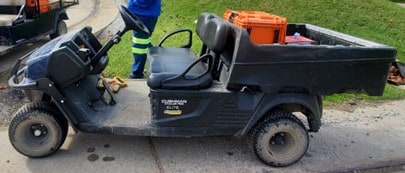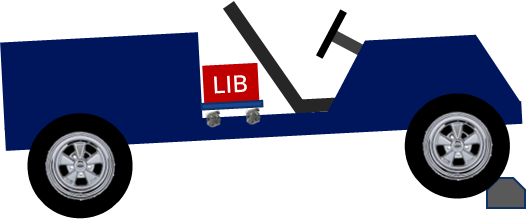Mining Project: Environmental Susceptibility of Mine Utility Vehicle and Rubber-Tired Mantrip Lithium-ion Batteries
| Principal Investigator |
|
|---|---|
| Start Date | 10/1/2023 |
| Objective |
The mining industry is adopting lithium-ion batteries (LIBs) for use in mobile equipment because LIBs offer performance and productivity improvements over traditional lead acid batteries. While equipment manufacturers are engineering large mobile equipment LIBs for the mining application, small mine utility vehicle (MUVs) and rubber-tired mantrips (RTM) manufacturers are more likely to use off-the-shelf LIBs that are not designed specifically for mining. Due to the risks associated with catastrophic LIB thermal runaway, research must be performed to determine if the severe mining environment could cause LIB thermal runaway on MUVs and RTMs. In particular, the effects of the mechanical shock, vibration, temperature, and relative humidity experienced in the mining environment on LIBs must be studied. Furthermore, installation methods must be developed to protect LIBs on MUVs and RTMs from the severe mining environment. |
| Topic Area |
Research Summary
Approach
The three research areas for this project are field data collection and analysis, test procedure development and laboratory testing, and LIB isolation system design. Field data collection and analysis consists of instrumenting MUVs and RTMs; measuring mechanical shock, vibration, temperature, and relative humidity; and analyzing the resulting data. Test procedure development and laboratory testing involves reviewing applicable LIB environmental test standards and guidelines, developing MUV/RTM mine-environment-specific LIB test procedures, and applying the developed test procedures to MUV and RTM LIBs. Project researchers will use the field data to determine the severity of laboratory LIB test conditions. LIB isolation system design combines vehicle dynamics simulation and physical testing to incorporate mechanical shock and vibration isolation into MUV and RTM LIB installation. The research areas for the project are interrelated. The field data will be used in both the laboratory testing and isolation system design. The laboratory testing will determine the maximum shock and vibration levels without harming MUV/RTM LIBs, and this information will be used in LIB isolation design.
Field data collection is paramount to the success of the project. Field data will be collected at a variety of mines across all commodities to ensure the resulting data captures the severest conditions for MUV/RTM batteries. Researchers will use the measured mechanical shock and vibration levels to develop an LIB accelerated life testing vibration profile so that a few months of laboratory testing can represent the damage done to LIBs over their multi-year service life. Furthermore, NIOSH will use the field data to determine the “road inputs” and vehicle response for use in the LIB isolation design.
On this project, NIOSH will collaborate with mines, mining companies, MUV/RTM manufacturers, LIB suppliers, testing laboratories, vibration isolator companies, and regulatory agencies. Cooperation with mines and mining companies is critical to the success of the field data collection efforts. Interactions with vehicle manufacturers and LIB suppliers will facilitate researchers’ understanding of vehicle- and battery-specific information. Discussions with testing laboratories will guide NIOSH efforts to apply the developed test procedure to MUV/RTM LIBs. Communication with vibration isolator companies will provide researchers with engineering information for simulations. Association with regulatory agencies will promote the development of guidance for MUV/RTM LIBs.
Milestones and Accomplishments
| Description | Audience | Year |
|---|---|---|
| Develop MUV/RTM environmental test standard | LIB suppliers, MUV/RTM manufacturers, regulatory agencies | 2025 |
| Conduct laboratory testing of MUV/RTM LIBs | LIB suppliers, MUV/RTM manufacturers, regulatory agencies | 2026 |
| Develop and evaluate LIB installation methods | LIB suppliers, MUV/RTM manufacturers, regulatory agencies | 2027 |
Planned Impacts and Outcomes
The intent of this project is to ensure that the LIBs used on MUVs/RTMs can safely endure the harsh mining environment without experiencing thermal runaway and other safety-related failures. The field data will enable researchers to develop a rigorous laboratory test procedure that is based on real environmental data versus using existing LIB environmental test standards, which are often based on hypothetical environmental conditions that do not reflect actual conditions. Conducting MUV/RTM LIB laboratory testing with real-world conditions will reveal whether LIB designs will experience failures and can be used to establish threshold mechanical shock and vibration levels at which high failure rates would occur with LIBs. The threshold levels will be used in LIB isolation system design.
MUV/RTM manufacturers, LIB suppliers, and government regulatory agencies will be able to use the above results in pursuit of preventing LIB safety-related issues. By examining LIB component failures that occur during laboratory testing, MUV/RTM manufacturers and LIB suppliers will be able to improve LIB designs to improve their durability. LIB suppliers can directly apply the developed test method to evaluate their batteries for use on MUVs and RTMs. MUV/RTM manufacturers can install LIB isolation to reduce shock and vibration transmitted to batteries. Finally, regulatory agencies can develop requirements for testing and installation of MUV/RTM LIBs to ensure safe operation.
Outputs
Several outputs will be used to disseminate the project’s findings. Initial findings will be presented at conferences and published in conference proceedings. Final results will be published in peer-reviewed journal articles. Field test results, a review of applicable LIB environmental test standards, laboratory LIB environmental test results, and selected incremental results from the LIB isolation research will be presented at the Society for Mining, Metallurgy & Exploration (SME) Annual Meeting and published in the conference proceedings. In addition to the SME conference papers, one or more conference papers may be presented at specialized technical conferences and published in their conference proceedings. One such specialized technical conference is ESTECH—a conference on environmental test and reliability—that is sponsored by the Institute of Environmental Science and Technology (IEST). Several peer-reviewed journal articles will be published once research in a particular area is well-established. One peer-reviewed publication will discuss the durability test vibration spectrum derived from the field data. Another peer-reviewed publication will describe the robust MUV/RTM LIB environmental test procedure. Upon completion of all laboratory LIB environmental tests, a peer-reviewed journal article that summarizes the laboratory testing will be published. The potential journals for the peer-reviewed articles include Mining, Metallurgy & Exploration; the International Journal of Mining Science and Technology, and the Journal of the IEST.
Supporting Visuals

Manufacturers are beginning to implement LIBs on MUVs and RTMs.

Vibration isolation can be used to reduce mechanical shock and vibration transmitted to LIBs.
- Characterizing the Generation and Mitigation of Hazardous Gases during Lithium-ion Battery Failure Events
- Development and Testing of a Mine Escape Vehicle (MEV)
- Diesel and Welding Aerosols in an Underground Mine
- Injuries Associated with Continuous Miners, Shuttle Cars, Load-haul-dump, and Personnel Transport in New South Wales Underground Coal Mines
- Mine Escape Vehicle Concept Investigation
- Mine Escape Vehicle Technology Retrofit Demonstration
- Mitigating Fire and Explosion Hazards of Lithium-ion Batteries
- Safety Concerns Associated With the Use of Electrically Powered Haulage to Remove Workers from Mines During Main Fan Stoppages